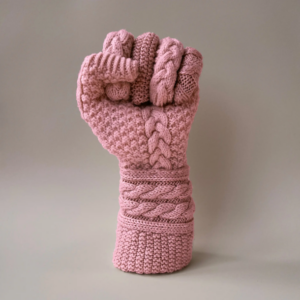The Revolutionary Power of Knitting
 Not long ago, Michelle Obama posted a black-and-white photo of herself on Instagram, cozy in an armchair, a nearby side table displaying an adorable baby pic of Malia and Sasha. She is barefoot, dressed in wide-legged jeans and a satin shirt, smiling widely as she looks down … at her knitting. “Every time I tell people how much I love to knit,” she writes in the caption, “They seem so surprised!”
Not long ago, Michelle Obama posted a black-and-white photo of herself on Instagram, cozy in an armchair, a nearby side table displaying an adorable baby pic of Malia and Sasha. She is barefoot, dressed in wide-legged jeans and a satin shirt, smiling widely as she looks down … at her knitting. “Every time I tell people how much I love to knit,” she writes in the caption, “They seem so surprised!”
And I thought, why?
I suspect it’s because knitters, unlike Mrs. Obama, are presumed to be aging ungracefully: prim, elderly (probably white) ladies rocking away on the porch in cultural irrelevance. Before I refute that — yarn lovers come in all ages, genders, sexualities and races — I want to ask, even if it were true, so what? The dismissal, the reflexive derision of women from midlife onward — especially if we stop chasing social media standards of beauty — is a nasty form of ageist sexism.
Besides, that imagined innocuousness can be a strength, even a superpower. Knitting is considered a “craft,” one you begin by “casting on,” evoking spells and witchery, a kind of practical magic. What greater sorcery is there, really, than making something, whether turning raw fiber to thread or raw flour to bread or engaging in the ultimate creative act: conjuring new humans from nowhere at all?
Our needles have also been a sharp political tool, wielded to fight injustice, to express both patriotism and protest, especially when other outlets were forbidden. No matter how you ended up feeling about those pink pussyhats, it was no accident that women’s first collective act of dissent after the election of President Donald Trump was to knit.
Back in the days of the American Revolution, women’s boycotts of British cloth in favor of “homespun,” and their defiant public “spinning bees” were at least as instrumental in the fight for independence as the spilling of all that tea. Molly Rinker, whose nickname was Old Mom, and who was one of the era’s fabled spies, reportedly tucked bits of information about British troop movements into balls of yarn. Who would suspect an aging matron, placidly knitting socks at a scenic overlook, of tossing message-laced skeins to the patriots? Knitting’s benign reputation allowed her to subvert the very conventions she appeared to uphold.
The French had their “tricoteuses,” which translates to women knitters (they have a word for that!), particularly those who, during the Reign of Terror, sat before the guillotines bearing grim witness to public executions. You may recall Madame Defarge from “A Tale of Two Cities,” whose stitches formed a Reaper’s roster of the condemned. Her real-life counterparts were equally complex, a mix of feminist hero and vengeful villain. Many (presumably savoring l’ironie) were said to knit liberty caps as the heads rolled: those red, conical hats with the point folded forward that represented freedom from tyranny. Marianne, a national symbol of France, is often depicted in a liberty cap. So, for reasons I cannot determine, is Papa Smurf.
Sojourner Truth offered a different twist on yarn and femininity during the Civil War, posing for photographs with her knitting, a nod to her belief that education and industry were the key to her community’s advancement. Decades later, when troops in World War I were dying by the tens of thousands from an epidemic of trench foot, caused by persistently wet toes, it was knitters to the rescue. The best defense was to change your socks — a lot — but factories of the time couldn’t handle the load, so home crafters produced them. I’m not saying we won that war because of women’s knitting, but I’m not sure we would’ve won without it.
Another activist first lady, Eleanor Roosevelt, was rarely without her knitting and began the Knit for Defense campaign during World War II. Similarly to Old Mom Rinker, female spies of the time used knitting as cover, one even parachuting behind enemy lines, then using her needles to transport secret code.
Today’s public knitters — and crocheters — are arguably more radical, perhaps in part because making something with your own hands almost by definition pushes back against dehumanizing technology and consumer culture. Knitters have mobilized against nuclear proliferation and the decimation of coral reefs. They have made blankets to welcome refugees; crafted tiny sweaters to save oil spill-damaged penguins; knit “temperature scarves” whose rows and colors document climate change; stitched for racial justice; sent handmade uteri to Congress in support of abortion rights (an especially apt political statement, since knitting needles were notoriously used, to women’s peril, in back-alley abortions). During the second Iraq war, a knitter in Denmark swathed a tank in a massive, homey knit blanket. The Russian feminist punk group Pussy Riot famously masked their identities beneath brightly colored knit balaclavas while performing songs such as “Putin’s Pissed Himself” and “Kill the Sexist.”